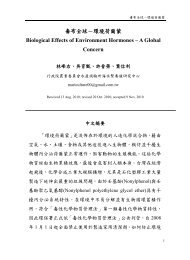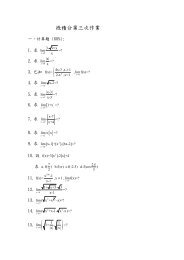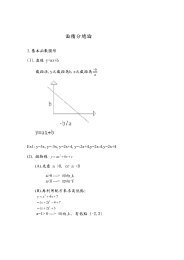Babel, a multilingual package for use with LATEX's ... - linsrv.net
Babel, a multilingual package for use with LATEX's ... - linsrv.net
Babel, a multilingual package for use with LATEX's ... - linsrv.net
Create successful ePaper yourself
Turn your PDF publications into a flip-book with our unique Google optimized e-Paper software.
level, as described below. In most cases, you will <strong>use</strong> only shorthands provided by<br />
languages.<br />
Please, note the following:<br />
1. Activated chars <strong>use</strong>d <strong>for</strong> two-char shorthands cannot be followed by a closing<br />
brace } and the spaces following are gobbled. With one-char shorthands<br />
(eg, :), they are preserved.<br />
2. If on a certain level (system, language, <strong>use</strong>r) there is a one-char shorthand,<br />
two-char ones starting <strong>with</strong> that char and on the same level are ignored.<br />
A typical error when using shorthands is the following:<br />
! Argument of \language@active@arg" has an extra }.<br />
It means there is a closing brace just after a shorthand, which is not allowed<br />
(eg, "}). Just add {} after (eg, "{}}).<br />
\shorthandon<br />
\shorthandoff<br />
{〈shorthands-list〉}<br />
* {〈shorthands-list〉}<br />
It is sometimes necessary to switch a shorthand character off temporarily, beca<strong>use</strong><br />
it must be <strong>use</strong>d in an entirely different way. For this purpose, the <strong>use</strong>r commands<br />
\shorthandoff and \shorthandon are provided. They each take a list of<br />
characters as their arguments.<br />
The command \shorthandoff sets the \catcode <strong>for</strong> each of the characters in its<br />
argument to other (12); the command \shorthandon sets the \catcode to active<br />
(13). Both commands only work on ‘known’ shorthand characters. If a character is<br />
not known to be a shorthand character its category code will be left unchanged.<br />
New 3.9 Note however, \shorthandoff does not behave as you would expect<br />
<strong>with</strong> characters like ~ or ^, beca<strong>use</strong> they usually are not “other”. For them<br />
\shorthandoff* is provided, so that <strong>with</strong><br />
\shorthandoff*{~^}<br />
~ is still active, very likely <strong>with</strong> the meaning of a non-breaking space, and ^ is the<br />
superscript character. The catcodes <strong>use</strong>d are those when the shorthands are<br />
defined, usually when language files are loaded.<br />
\<strong>use</strong>shorthands<br />
* {〈char〉}<br />
The command \<strong>use</strong>shorthands initiates the definition of <strong>use</strong>r-defined shorthand<br />
sequences. It has one argument, the character that starts these personal<br />
shorthands.<br />
New 3.9 However, <strong>use</strong>r shorthands are not always alive, as they may be<br />
deactivated by languages (<strong>for</strong> example, if you <strong>use</strong> " <strong>for</strong> your <strong>use</strong>r shorthands and<br />
switch from german to french, they stop working). There<strong>for</strong>e, a starred version<br />
\<strong>use</strong>shorthands*{〈char〉} is provided, which makes sure shorthands are always<br />
activated.<br />
Currently, if the <strong>package</strong> option shorthands is <strong>use</strong>d, you must include any<br />
character to be activated <strong>with</strong> \<strong>use</strong>shorthands. This restriction will be lifted in a<br />
future release.<br />
7

















